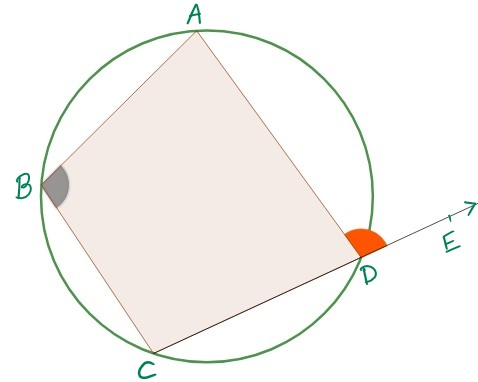Grade 8B ATA : Circle Theorems
APPLET 1
1. How many PINK angles fit inside the BLUE angle? [1]
2. Given your result for (1), how does the measure of the pink angle compare with the measure of the blue angle? [1]
3. Try testing your informal conclusions for (responses to) (1) and (2) a few times by dragging the slider back to its starting position, changing the location of the pink angle, and changing the size of the blue arc. Then slide the slider again. Now generalize the observations in a statement. You must use the terms 'subtended' and 'circumference' in your statement [1]
APPLET 2
4. What do you observe when you drag any of the points E, F, Q over each other? [1]
5. Is there truly a "best" place to sit on this circle in order to have the "best" viewing angle? Explain. [1]
6. The Stage and the remaining part of the circular area form two 'segments' of the circle. Write the property with respect to the angles observed in the above activity. Use the term 'segment' in your statement. [1]
APPLET 3
7. Drag the point C to point F and point E to G. Ensure the points are as close to each other as possible and overlap each other. What is the measure of angle CDE? [1]
8. Now drag the point D anywhere in the red part of the arc. What do you observe? [1]
9. Justify the observation in Q8 based on the observations/conclusions drawn in Q1 to 6
10. Now change the position of the diameter by dragging the point F to any other position. Again drag the point C to point F and point E to G as in Q7. What is the measure of angle CDE now?
11. With point C overlapping point F and point E overlapping point G, the Red and Blue arcs have their end points on the diameter FG? What are such arcs called?
12. Based on your answers to Q7 - Q11, generalize the property observed in a single statement.
13.
APPLET 4
14. Suppose, in the applet above, the brown angle measures 76 degrees. What would the measure of the blue angle be?
15. Suppose, in the applet above, the pink angle measures 130 degrees. What would the measure of the green angle be?
16. From what you've observed, how would you describe the relationship between any pair of opposite angles of a cyclic quadrilateral?
Image 1

17. State the relation, if any between angle ABC and angle ADE? (Hint : you may use the applet given before Q14)
18. Will the above relation be true for all Cyclic Quadrilaterals? If so, write a general statement stating the property/theorem.
19. Will the property stated in Q18 hold for any other quadrilateral which is not cyclic? Justify. (you may draw a diagram to explain the same) [2]